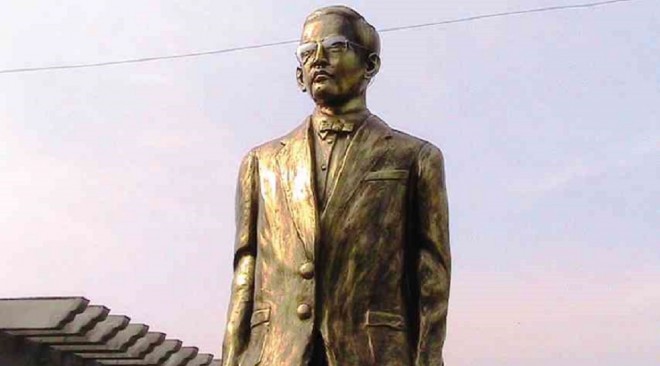
EPIFANIO de los Santos, the man after whom the longest highway in Metro Manila was named, is honored with a 10-foot-high bronze statue in San Isidro town, Nueva Ecija province. ARMAND GALANG/INQUIRER NORTHERN LUZON
SAN ISIDRO, Nueva Ecija—The man after whom the longest highway in Metro Manila is named has been honored with a 10-foot-high bronze statue that now stands facing the historic town hall here.
The statue of ss, the first Filipino governor of Nueva Ecija province, was unveiled during rites on Thursday, with most of his descendants in attendance. Among them were De los Santos’ great granddaughter, former Press Undersecretary Carmen “Ching” de los Santos-Suva, and members of Class 1958 of General de Jesus College, which lobbied for the statue’s commission.
Dr. Romeo Lorenzo, class president, said they pushed for the statue because of an insight from one of their former classmates who was stuck in traffic along Epifanio de los Santos Avenue (Edsa).
“The vehicle’s driver informed the classmate, ‘We are on Edsa,’ and our classmate realized that the avenue was named after the former governor,” Lorenzo narrated.
He said the monument was meant “to immortalize the greatness of a man who lived before us and to serve as an inspiration to generations to come.”
Lorenzo said “Don Pañong,” De los Santos’ nickname, was one of the most illustrious sons of Nueva Ecija.
Reflecting on the statue, he said it was “long overdue.” The statue stands at Plaza De los Santos, facing the municipal hall and the local church.
Mayor Cesario Lopez Jr. said the statue was commissioned by virtue of a municipal resolution.
Suva thanked the town government and Class 1958 for pursuing the project.
De los Santos was described as the “greatest Filipino genius after Rizal.” He was the first Filipino to be elected Nueva Ecija governor in 1902. He was reelected in 1904.
Born on April 7, 1871, in Malabon, De los Santos was the only child of Don Escolastico de los Santos and Doña Antonina Cristobal.
He graduated summa cum laude with a Bachelor of Arts degree at Ateneo de Manila University, studied law at the University of Santo Tomas and was the bar topnotcher in 1898.
De los Santos was a bibliographer, artist, biographer, civil servant, critic, essayist, ethnographer, journalist, historian, jurist, librarian, linguist and polyglot, monographer, musician, novelist, paleographer, philanthropist, philologist, philosopher, poet, researcher and revolutionary leader.
He also served as associate editor of La Independencia, a revolutionary newspaper in 1898. In 1900, he was named district attorney of this town and provincial fiscal of Bulacan and Bataan in 1904.
He was known to have built the largest collection of books and antiquities in the country, including 2,000 titles.
De los Santos died of cardiac arrest on April 28, 1928, in Manila at the age of 57.
In recognition of his contributions to the arts, culture and history, the 23.8-kilometer Highway 54 passing through six cities and 17 towns in Metro Manila was named after him by virtue of Republic Act No. 2140, which was enacted on April 7, 1959. Armand Galang, Inquirer Central Luzon